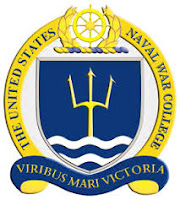Unmanned Systems & Strategic Futures at the Naval War College
The Naval War College remains the center of the U.S. Navy's foremost strategic thinkers. Later this month, various experts from the military, academia, and policy communities will convene in Newport for a maritime strategy symposium.
Some of the presenters will focus on the impact that unmanned vehicles have produced on naval strategy. From the Naval Post-graduate School, retired Navy Captain Jeff Kline will discuss his paper on Impacts of the Robotics Age on Naval Force Structure Planning."Captain Kline’s paper emphasizes the importance of offensive “payload over platforms,” in order to overcome impediments to enhancing future force structure. In his words,
“This package focus” first is particularly applicable in the electromagnetic and cyber realm. Inexpensive, deposable UAVs employing radar reflectors or chirp jamming may be better delivery platforms for EM “packages” than an F-18 Growler. In the offense, developing “Left of kill chain” effects against an adversary need not be expensive, but does require synchronization with the movement of actual forces.Retired Captain Jerry Hendrix, from the Center for New American Security, argues for investing in change by introducing innovative naval capabilities. These technologies would bring future conflicts to a swift victory by targeting an enemy’s national leadership.
If the United States were to go to war again it must leverage the technologies it has, a superb intelligence-reconnaissance complex as well as a precision strike capability unlike any other nation on earth, and combine these with newly emerging capabilities; unmanned and man-machine platforms, directed energy weapons, electro-magnetic and hypersonics to identify, target and destroy the critical center of gravity within the enemy camp.
 Joining Captain Hendrix on the force structure panel is Lena S. Andrews, a PhD candidate in Political Science and a member of the Security Studies Program at MIT, who recognizes that new technologies introduce new risks. In her War on the Rocks article, Ms. Andrews and her coauthor Julia Macdonald warn that the increased reliability on satellite data connections and space technologies which have enabled the unmanned intelligence, surveillance, and reconnaissance revolution create a cyber capability-vulnerability paradox.
Joining Captain Hendrix on the force structure panel is Lena S. Andrews, a PhD candidate in Political Science and a member of the Security Studies Program at MIT, who recognizes that new technologies introduce new risks. In her War on the Rocks article, Ms. Andrews and her coauthor Julia Macdonald warn that the increased reliability on satellite data connections and space technologies which have enabled the unmanned intelligence, surveillance, and reconnaissance revolution create a cyber capability-vulnerability paradox. In the paper “Future Maritime Forces: Unmanned, Autonomous, and Lethal,” the War College’s own William F. Bundy foresees that the combination of distributed lethality and unmanned systems will revolutionize future naval warfare. His vision is that advanced unmanned air, surface, and subsurface platforms operating off surface ships and governed by artificial intelligence will be able to conform to safety of flight and navigation and the laws of armed conflict.


Comments
Post a Comment